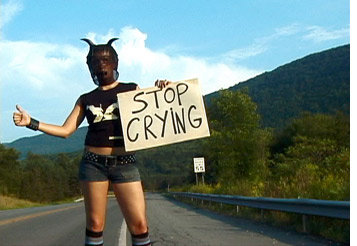Meme: Romanticism
dal 15/2/2007 al 30/3/2007
Segnalato da
Tobias Bernstrup
Jeremy Blake
Claudia Hart
Michelle Handelman
Reynold Reynolds
Partick Jolley
Carlo Zanni
Michele Thursz
15/2/2007
Meme: Romanticism
Efa Project Space, New York
Tobias Bernstrup, Jeremy Blake, Claudia Hart, Michelle Handelman, Reynold Reynolds and Partick Jolley, and Carlo Zanni

Organized by Michele Thursz
Artists: Tobias Bernstrup, Jeremy Blake, Claudia Hart, Michelle Handelman, Reynold Reynolds and Partick Jolley, and Carlo Zanni
"I want to compete with the movies"
Meme: Romanticism examines five artists' cinematic productions that utilize technological aesthetics, cultural symbolism, historic compositions, and narratives to expose the conceptual underpinning of Romanticism. The exhibition will be set up like a theater, with viewing times allocated by length of the video. The room will have a sound system and projection with seating for the viewer’s comfort, so they may enjoy the works. The waiting area will be set up as a traditional gallery space with prints derived or inspired by the films, but still functioning as unique objects.
The exhibition includes the artist collaborative feature film Sugar and prints by Reynold Reynolds and Patrick Jolley; Mantis City, a video and print by Tobias Bernstrup; Winchester Trilogy, videos and print by Jeremy Blake; The Possible Ties Between Illness and Success, an interactive video and prints Carlo Zanni; This Delicate Monster, video and prints by Michelle Handelman; and The Swing, 3-D animation and prints by Claudia Hart.
Romanticism as a movement emerged in the late 1700s. Artists took a stance against formal aesthetics to define art as a place for sentiment, nature, and the play of the imagination. This was an idea of art in which individuals shared their subjective realities with the public. Since that time, technologies of representation have advanced from still to moving images, from early cinema to Hollywood films to personal computers and the Internet. A social medium of representation unfolded with the capability to archive and to edit histories, identities, and geographies. These capabilities allow the public to participate in fantastic situations. Movies became popular because they reflect the dreams, fears, or fantasies of a mass public. The impact of Hollywood film and mass media is intriguing sociologically: How does consumer culture affect the personal? How does it effect the way people define their own identities?
Artists of the 50s and 60s started using the machinery of commercial culture to create and engage a broad public. This tendency was later identified as “Pop”. Today’s contemporary artist raises the ante of the Pop aesthetic by creating works that reflect our communal experiences. Communality is the key to the success of the movies and mass media; both use the tactic of bringing together a general consensus and the popular. The market and the media are based on the human need to share—empathy, opinion, and history—making the media generative by the public and the media reflecting back and forth on each other.
In the contemporary art context these cinematic or communal works become the romantic concept of the Gesamtkunstwerk, the total work of art. The exhibited works are cinematic and poetic by the nature of their production and their narratives. They reference historic compositions to create an emotional outlook on nature. These works are also a good index of the values and needs of our society because they are invested in our cultural life. In them the hierarchies and histories of art making is deconstructed and reapplied to these artists’ craft and aesthetics, aligning theirs artistic intention with the ideas of romanticism.
Meme: Romanticism suggests that Romanticism was more than a formal movement of the past but successful in changing and adapting with the times and the exigencies of history—and with the needs contemporary art making. Michele Thursz, 2006
Michele Thursz is an independent curator. Recently she has been appointed as the director of NY Projects, an international art advisory and production company. Her previous projects include Post Media Network; Post Media is a term and action demonstrating the continuous evolution of uses of media and its effect on artists practice, and culture-at-large. Thursz' recent curatorial projects include Thread, Wood Street Gallery, Pattern: Modernism as Mediator, Borusan Gallery, Istanbul, Cine-O-matic, The New Museum, public.exe: Public Execution, Exit Art, NYC, and Democracy is Fun, White Box, NYC.
Contact: michele.thursz@gmail.com
This exhibition is presented by the EFA Gallery, a program of The Elizabeth Foundation for the Arts. With additional support from The Helen Keeler Burke Charitable Foundation, Peter C. Gould, Materials for the Arts, and Carnegie Corporation Inc. and many generous individuals.
The EFA Gallery is a curatorial project space. Through the gallery, The Elizabeth Foundation for the Arts supports the creative work of independent curators. Curators build the framework in which we understand artists and the art they make. At their best, they redefine how we look at culture. The Elizabeth Foundation for the Arts believes in the essential importance of art in a civil society. The value of the artist's creative spirit is not limited by age, race, nationality or acceptance by others.
Screenings Wednesday through Saturday:
Winchester Trilogy: 12PM, 2PM
Mantis City: 1PM, 3PM
This Delicate Monster: 1:30PM, 3:30
Folly & Error: 1:40PM: 3:40
The Possible Ties Between Illness and Success: 1:50, 3:45PM
Sugar: 4-6PM
For video synopsis: http://meme-romanticism.blogspot.com
The Swing and the prints are in the main gallery.
For further information:
Elaine Tin Nyo, Director
T. 212-563-5855 x203, F. 212-563-1875 elaine@efa1.org
Opening Reception, February 16, 6:00-8:00 pm
EFA Gallery
323 West 39th Street 11th Floor - New York
Gallery Hours: Wed. through Sat. 12-6 PM





